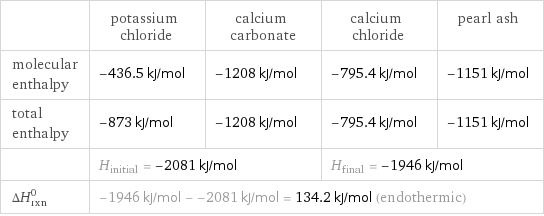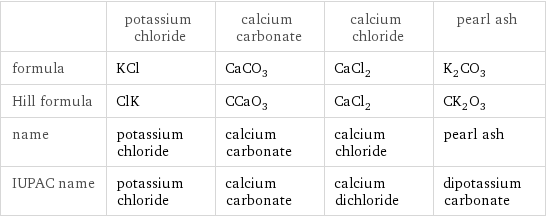Input interpretation

KCl potassium chloride + CaCO_3 calcium carbonate ⟶ CaCl_2 calcium chloride + K_2CO_3 pearl ash
Balanced equation

Balance the chemical equation algebraically: KCl + CaCO_3 ⟶ CaCl_2 + K_2CO_3 Add stoichiometric coefficients, c_i, to the reactants and products: c_1 KCl + c_2 CaCO_3 ⟶ c_3 CaCl_2 + c_4 K_2CO_3 Set the number of atoms in the reactants equal to the number of atoms in the products for Cl, K, C, Ca and O: Cl: | c_1 = 2 c_3 K: | c_1 = 2 c_4 C: | c_2 = c_4 Ca: | c_2 = c_3 O: | 3 c_2 = 3 c_4 Since the coefficients are relative quantities and underdetermined, choose a coefficient to set arbitrarily. To keep the coefficients small, the arbitrary value is ordinarily one. For instance, set c_2 = 1 and solve the system of equations for the remaining coefficients: c_1 = 2 c_2 = 1 c_3 = 1 c_4 = 1 Substitute the coefficients into the chemical reaction to obtain the balanced equation: Answer: | | 2 KCl + CaCO_3 ⟶ CaCl_2 + K_2CO_3
Structures

+ ⟶ +
Names

potassium chloride + calcium carbonate ⟶ calcium chloride + pearl ash
Reaction thermodynamics
Enthalpy

| potassium chloride | calcium carbonate | calcium chloride | pearl ash molecular enthalpy | -436.5 kJ/mol | -1208 kJ/mol | -795.4 kJ/mol | -1151 kJ/mol total enthalpy | -873 kJ/mol | -1208 kJ/mol | -795.4 kJ/mol | -1151 kJ/mol | H_initial = -2081 kJ/mol | | H_final = -1946 kJ/mol | ΔH_rxn^0 | -1946 kJ/mol - -2081 kJ/mol = 134.2 kJ/mol (endothermic) | | |
Gibbs free energy

| potassium chloride | calcium carbonate | calcium chloride | pearl ash molecular free energy | -408.5 kJ/mol | -1129 kJ/mol | -748.8 kJ/mol | -1064 kJ/mol total free energy | -817 kJ/mol | -1129 kJ/mol | -748.8 kJ/mol | -1064 kJ/mol | G_initial = -1946 kJ/mol | | G_final = -1812 kJ/mol | ΔG_rxn^0 | -1812 kJ/mol - -1946 kJ/mol = 133.8 kJ/mol (endergonic) | | |
Equilibrium constant
![Construct the equilibrium constant, K, expression for: KCl + CaCO_3 ⟶ CaCl_2 + K_2CO_3 Plan: • Balance the chemical equation. • Determine the stoichiometric numbers. • Assemble the activity expression for each chemical species. • Use the activity expressions to build the equilibrium constant expression. Write the balanced chemical equation: 2 KCl + CaCO_3 ⟶ CaCl_2 + K_2CO_3 Assign stoichiometric numbers, ν_i, using the stoichiometric coefficients, c_i, from the balanced chemical equation in the following manner: ν_i = -c_i for reactants and ν_i = c_i for products: chemical species | c_i | ν_i KCl | 2 | -2 CaCO_3 | 1 | -1 CaCl_2 | 1 | 1 K_2CO_3 | 1 | 1 Assemble the activity expressions accounting for the state of matter and ν_i: chemical species | c_i | ν_i | activity expression KCl | 2 | -2 | ([KCl])^(-2) CaCO_3 | 1 | -1 | ([CaCO3])^(-1) CaCl_2 | 1 | 1 | [CaCl2] K_2CO_3 | 1 | 1 | [K2CO3] The equilibrium constant symbol in the concentration basis is: K_c Mulitply the activity expressions to arrive at the K_c expression: Answer: | | K_c = ([KCl])^(-2) ([CaCO3])^(-1) [CaCl2] [K2CO3] = ([CaCl2] [K2CO3])/(([KCl])^2 [CaCO3])](../image_source/76461762fed6ed94380a1bea1af36739.png)
Construct the equilibrium constant, K, expression for: KCl + CaCO_3 ⟶ CaCl_2 + K_2CO_3 Plan: • Balance the chemical equation. • Determine the stoichiometric numbers. • Assemble the activity expression for each chemical species. • Use the activity expressions to build the equilibrium constant expression. Write the balanced chemical equation: 2 KCl + CaCO_3 ⟶ CaCl_2 + K_2CO_3 Assign stoichiometric numbers, ν_i, using the stoichiometric coefficients, c_i, from the balanced chemical equation in the following manner: ν_i = -c_i for reactants and ν_i = c_i for products: chemical species | c_i | ν_i KCl | 2 | -2 CaCO_3 | 1 | -1 CaCl_2 | 1 | 1 K_2CO_3 | 1 | 1 Assemble the activity expressions accounting for the state of matter and ν_i: chemical species | c_i | ν_i | activity expression KCl | 2 | -2 | ([KCl])^(-2) CaCO_3 | 1 | -1 | ([CaCO3])^(-1) CaCl_2 | 1 | 1 | [CaCl2] K_2CO_3 | 1 | 1 | [K2CO3] The equilibrium constant symbol in the concentration basis is: K_c Mulitply the activity expressions to arrive at the K_c expression: Answer: | | K_c = ([KCl])^(-2) ([CaCO3])^(-1) [CaCl2] [K2CO3] = ([CaCl2] [K2CO3])/(([KCl])^2 [CaCO3])
Rate of reaction
![Construct the rate of reaction expression for: KCl + CaCO_3 ⟶ CaCl_2 + K_2CO_3 Plan: • Balance the chemical equation. • Determine the stoichiometric numbers. • Assemble the rate term for each chemical species. • Write the rate of reaction expression. Write the balanced chemical equation: 2 KCl + CaCO_3 ⟶ CaCl_2 + K_2CO_3 Assign stoichiometric numbers, ν_i, using the stoichiometric coefficients, c_i, from the balanced chemical equation in the following manner: ν_i = -c_i for reactants and ν_i = c_i for products: chemical species | c_i | ν_i KCl | 2 | -2 CaCO_3 | 1 | -1 CaCl_2 | 1 | 1 K_2CO_3 | 1 | 1 The rate term for each chemical species, B_i, is 1/ν_i(Δ[B_i])/(Δt) where [B_i] is the amount concentration and t is time: chemical species | c_i | ν_i | rate term KCl | 2 | -2 | -1/2 (Δ[KCl])/(Δt) CaCO_3 | 1 | -1 | -(Δ[CaCO3])/(Δt) CaCl_2 | 1 | 1 | (Δ[CaCl2])/(Δt) K_2CO_3 | 1 | 1 | (Δ[K2CO3])/(Δt) (for infinitesimal rate of change, replace Δ with d) Set the rate terms equal to each other to arrive at the rate expression: Answer: | | rate = -1/2 (Δ[KCl])/(Δt) = -(Δ[CaCO3])/(Δt) = (Δ[CaCl2])/(Δt) = (Δ[K2CO3])/(Δt) (assuming constant volume and no accumulation of intermediates or side products)](../image_source/159f71466e6302191bed215ea88a603c.png)
Construct the rate of reaction expression for: KCl + CaCO_3 ⟶ CaCl_2 + K_2CO_3 Plan: • Balance the chemical equation. • Determine the stoichiometric numbers. • Assemble the rate term for each chemical species. • Write the rate of reaction expression. Write the balanced chemical equation: 2 KCl + CaCO_3 ⟶ CaCl_2 + K_2CO_3 Assign stoichiometric numbers, ν_i, using the stoichiometric coefficients, c_i, from the balanced chemical equation in the following manner: ν_i = -c_i for reactants and ν_i = c_i for products: chemical species | c_i | ν_i KCl | 2 | -2 CaCO_3 | 1 | -1 CaCl_2 | 1 | 1 K_2CO_3 | 1 | 1 The rate term for each chemical species, B_i, is 1/ν_i(Δ[B_i])/(Δt) where [B_i] is the amount concentration and t is time: chemical species | c_i | ν_i | rate term KCl | 2 | -2 | -1/2 (Δ[KCl])/(Δt) CaCO_3 | 1 | -1 | -(Δ[CaCO3])/(Δt) CaCl_2 | 1 | 1 | (Δ[CaCl2])/(Δt) K_2CO_3 | 1 | 1 | (Δ[K2CO3])/(Δt) (for infinitesimal rate of change, replace Δ with d) Set the rate terms equal to each other to arrive at the rate expression: Answer: | | rate = -1/2 (Δ[KCl])/(Δt) = -(Δ[CaCO3])/(Δt) = (Δ[CaCl2])/(Δt) = (Δ[K2CO3])/(Δt) (assuming constant volume and no accumulation of intermediates or side products)
Chemical names and formulas

| potassium chloride | calcium carbonate | calcium chloride | pearl ash formula | KCl | CaCO_3 | CaCl_2 | K_2CO_3 Hill formula | ClK | CCaO_3 | CaCl_2 | CK_2O_3 name | potassium chloride | calcium carbonate | calcium chloride | pearl ash IUPAC name | potassium chloride | calcium carbonate | calcium dichloride | dipotassium carbonate
Substance properties

| potassium chloride | calcium carbonate | calcium chloride | pearl ash molar mass | 74.55 g/mol | 100.09 g/mol | 111 g/mol | 138.2 g/mol phase | solid (at STP) | solid (at STP) | solid (at STP) | solid (at STP) melting point | 770 °C | 1340 °C | 772 °C | 891 °C boiling point | 1420 °C | | | density | 1.98 g/cm^3 | 2.71 g/cm^3 | 2.15 g/cm^3 | 2.43 g/cm^3 solubility in water | soluble | insoluble | soluble | soluble odor | odorless | | |
Units
